Reserve Bank of Australia Annual Report – 2017 Operations in Financial Markets
The Reserve Bank operates in domestic and international financial markets in order to meet the Bank's policy objectives. These include implementing the monetary policy decisions of the Reserve Bank Board, facilitating the smooth functioning of the payments system, managing the nation's foreign exchange reserve assets and providing banking services to clients (mainly the Australian Government and foreign central banks).
Balance Sheet
Over the past year, the Reserve Bank's balance sheet expanded by $27 billion to around $194 billion. On the liabilities side of the balance sheet, the increase largely reflected a rise in funds held on deposit by the Australian Government. These deposits vary considerably over the course of the year as a result of the pattern of government receipts and expenditure. Banknotes on issue grew by around $3 billion, broadly in line with the increase seen in recent years. To offset the withdrawal of liquidity from the financial system arising from these transactions, the Reserve Bank increased its holdings of domestic securities held under reverse repurchase agreement (repo) and foreign exchange swaps.


Domestic Market Operations
Monetary policy implementation
The Reserve Bank Board's operational target for monetary policy is the cash rate – the rate at which banks borrow and lend to each other on an overnight, unsecured basis. The cash rate is a significant financial benchmark referenced in overnight indexed swaps and ASX's 30-day interbank cash rate futures contract. The Board adjusted the cash rate target once during 2016/17, from 1.75 per cent to 1.5 per cent in August 2016. During 2016/17, the daily liquidity management operations of the Reserve Bank were conducted so as to ensure that the cash rate remained consistent with the target set by the Board on all days.
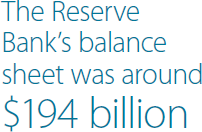
The Reserve Bank is also responsible for calculating the cash rate. The Bank calculates the cash rate directly from market transactions, sourcing individual transaction data from the Reserve Bank Information and Transfer System (RITS). In 2016/17, there were around 35 cash market transactions each day, with aggregate daily activity in the cash market averaging around $4.5 billion.
The funds traded in the cash market are the balances held by financial institutions in their Exchange Settlement Accounts (ESAs) at the Reserve Bank. These accounts are held by around 95 financial institutions and are used to settle payment obligations between these institutions. The aggregate level of Exchange Settlement (ES) balances changes as a result of transactions between customers of the Bank (principally the Australian Government) and ESA holders. The Bank also undertakes transactions on its own behalf to affect the level of ES balances. This includes undertaking repos collateralised with eligible securities, buying or selling government securities on an outright basis, or using foreign exchange swaps involving Australian dollars. The Bank conducts these transactions with a view to maintaining the aggregate level of ES balances consistent with demand at the cash rate target.
The bulk of ES balances arise from ‘open repos’ (that is, repos contracted without a maturity date) contracted with the Reserve Bank by financial institutions to meet their liquidity needs outside of normal banking hours. As these balances are remunerated at the cash rate target and are held to facilitate the smooth operation of the payments system, they have no implications for the implementation of monetary policy. At the end of June 2017, these balances were $26 billion.
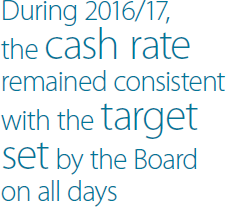
The remainder of ES balances, referred to as surplus ES balances, were steady at around $2 billion during 2016/17. These surplus balances are remunerated at a level that is 25 basis points below the cash rate target, and therefore ESA holders typically aim to maintain their accounts with a small positive (surplus) balance. Day-to-day demand for these surplus ES balances can be volatile for a number of reasons, including because, at times, some institutions choose to hold ES balances as high-quality liquid assets to comply with the Liquidity Coverage Ratio (LCR) framework. There can also be seasonal demand for liquidity around the end of each calendar quarter.
Open market operations
On a day-to-day basis, the Reserve Bank transacts in domestic markets to offset the effect on the supply of ES balances arising from payment flows between ESA holders and the Bank, and to accommodate changes in aggregate demand for ES balances by financial institutions. Most of the Bank's transactions in the domestic market are reverse repos contracted as part of its regular morning open market operations.[1] In conducting its operations, the Bank takes account of forecast changes in liquidity, as well as the pricing of the bids and offers received against prevailing market rates. In 2016/17, the repo transactions conducted in these operations had an average maturity at origination of around 35 days, and a maximum term of around six months. Reflecting the role that repos play in managing system liquidity, the size of the Bank's repo book ranged between $47 billion and $64 billion during the financial year.
To ensure that unexpected payment flows during the day do not adversely affect the cash rate, the Reserve Bank has the option of undertaking additional rounds of market operations in the late afternoon. Such additional rounds were announced, on average, five times per month during 2016/17, with 60 per cent of these operations offering to inject additional liquidity into the system. Terms for these operations are much shorter than the morning operations, with a maximum term of 11 days in 2016/17. In the event of unforeseen liquidity developments in the evening, further additional rounds can be announced if the need arises, although no such operations were conducted in 2016/17.
In March 2017, the Reserve Bank launched a new dealing system to conduct its open market operations. Prior to this new system, a number of manual processes were required to set up the Bank's dealing rounds, and individual counterparties were notified of their results by telephone shortly after the conclusion of the operation. The new system automates these processes, including publishing the Bank's dealing intentions to the market data services, creating transaction exposures in the Bank's treasury management system and electronically notifying individual counterparties of their results.
Over recent years, the Reserve Bank has increased its use of foreign exchange swaps when managing system liquidity (swapping Australian dollars for foreign currencies alters the supply of ES balances in the same way as a repo transaction).[2] This has been necessitated by the limited capacity of the domestic repo market to absorb large fluctuations in the Bank's positions, such as those associated with large maturities of Australian Government Securities (AGS). Compared with the Australian repo market, the foreign exchange swap market has greater depth and liquidity. Reflecting the role of the Bank's foreign exchange swaps in assisting with short-term liquidity management, these swaps have typically been contracted at maturities of three months or fewer.
The Reserve Bank also purchases government securities on an outright basis to assist in the management of large AGS maturities. This reflects the Bank's need to mitigate the liquidity impact on the maturity date of the funds that are paid out of the Australian Government's account at the Bank into ESAs (for the credit of the security holder). These purchases are carried out using near-to-maturity securities and for liquidity management purposes. They have no implications for the stance of monetary policy. To offset the liquidity effect of AGS maturities, the Bank purchased $13 billion of the February 2017 bond prior to its maturity. In preparation for the large AGS maturities scheduled for 2017/18, by the end of June 2017 the Bank had purchased $8.9 billion of the July 2017 bond and $6.8 billion of the January 2018 bond. The Bank's outright holdings of AGS are published monthly on the Bank's website.
The Reserve Bank also holds a small amount of longer-term semi-government securities (semis) on an outright basis in its domestic portfolio. These are available to be sold as collateral under repo. At the end of the financial year, the Bank held around $2.5 billion of semis on an outright basis. These securities are generally purchased as part of the Bank's daily open market operations or separately through outright purchase operations. The latter, which are conducted over the Yieldbroker DEBTS trading platform, occurred four times in 2016/17.
The Reserve Bank continues to operate a Securities Lending Facility on behalf of the Australian Office of Financial Management. The securities available through the facility comprise all Treasury Bonds and Treasury Indexed Bonds currently on issue. The Bank sells these securities either for intraday or open repos to RITS members eligible to participate in the Bank's domestic market operations.
Standing facilities
Separate from its open market operations, the Reserve Bank also provides certain standing facilities, primarily to support the functioning of the payments system. Through these facilities, eligible counterparties transact with the Bank on pre-arranged terms, with liquidity made available via repos. The most frequently used standing facilities are those for the provision of intraday liquidity to ESA holders. The Bank can also extend overnight funding via repo where an ESA holder faces a shortage in ES balances that cannot be borrowed from another financial institution; such funding is extended at an interest rate 25 basis points above the cash rate target. During 2016/17, ESA holders accessed overnight funding from the Bank on three occasions.
Open repos are provided under the Reserve Bank's standing facilities for ESA holders that have to settle payment obligations outside normal business hours, such as ‘direct-entry’ payments. Open repos will also be used to facilitate the settlement of after-hours transactions through the New Payments Platform. As at the end of June 2017, 15 financial institutions had open repo positions with the Bank, valued at around $26 billion. These amounts were increased by $4 billion in February 2017 to cater for growth in direct-entry payments after normal business hours. To collateralise these open repos, the Bank has permitted the use of certain related-party assets issued by bankruptcy remote vehicles, such as self-securitised residential mortgage-backed securities (RMBS).
Eligible securities
The Reserve Bank has established criteria that determine which securities are eligible to be purchased under repo in the Bank's domestic market operations. To protect against a decline in the value of the collateral securities should the Bank's counterparty not meet its repurchase obligation, the Bank requires the value of the security to exceed the cash lent by a certain margin. These margins, which are listed on the Bank's website, are considerably higher for securities that are not issued by governments.[3] From time to time, the Bank reviews its eligibility criteria and the margin schedule. In June 2017, the Bank widened the eligibility criteria for longer-term securities issued by authorised deposit-taking institutions (ADIs) to include all those in a broader investment grade ‘BBB basket’; prior to this review, such securities needed to have a minimum credit rating of BBB+ to be eligible. In order to ensure that the risks of purchasing lower-rated securities under repo are managed appropriately, the margins applied to securities in this basket were increased.
Participants in the Reserve Bank's market operations tend to be the fixed-income trading desks of banks and securities firms seeking to finance their inventories of AGS and semis, as well as bank treasuries. Reflecting this, over half of the securities held by the Bank (excluding those under open repo) are government-related obligations, with most of the remainder being bank-issued debt securities and RMBS.
Domestic securities purchased by the Reserve Bank are held for safe custody in an account that the Bank maintains in Austraclear, the securities depository and registry operated by ASX. Securities transactions conducted between the Bank and its counterparties are settled in the Austraclear system, mostly on a bilateral basis. The Bank also settles repo transactions contracted in its open market operations within ASX Collateral, a collateral management service. During 2016/17, around 20 per cent of the total amount of securities the Bank purchased under repo was settled within ASX Collateral, up from around 10 per cent in 2015/16.
Asset-backed securities form a significant share of the collateral securities the Reserve Bank purchases under open repo. Around 95 per cent of the outstanding amount of open repos is backed by self-securitised RMBS. Asset-backed securities – particularly self-securitised RMBS – are also the major asset provided as collateral for the Committed Liquidity Facility (CLF). Self-securitised RMBS used in open repos do not have directly observable market prices, as they are retained in full by the bankruptcy remote trusts of originating institutions and are therefore not traded. As a result, the Bank uses an internal valuation model for self-securitised RMBS based on observed market prices of similarly structured RMBS; this internal model is externally reviewed.
Given the importance of asset-backed securities to the Reserve Bank's operations, the Bank has mandatory reporting requirements for securitisations to remain eligible for repo. In 2016/17, the Bank received around 3,600 monthly data submissions on around 300 asset-backed transactions from issuers or their appointed information providers. For eligible RMBS, this covers around two million underlying individual housing loans with a combined balance of around $400 billion, which is around one-quarter of the total value of housing loans in Australia. The required data include key information on the structure of the RMBS and the relationships among counterparties within the RMBS structure; the required data also include information on the residential mortgage loans and the underlying collateral backing the RMBS structure.
| June 2015 | June 2016 | June 2017 | ||||
|---|---|---|---|---|---|---|
| $ billion | Per cent of total | $ billion | Per cent of total | $ billion | Per cent of total | |
| AGS | 22.8 | 28 | 32.8 | 35 | 43.8 | 43 |
| Semis | 11.3 | 14 | 7.4 | 8 | 6.2 | 6 |
| Supranational | 4.7 | 6 | 3.4 | 4 | 3.5 | 3 |
| Government guaranteed | 0.0 | 0 | 0.0 | 0 | 0.0 | 0 |
| ADI issued | 16.1 | 20 | 16.8 | 18 | 12.5 | 12 |
| Asset-backed securities | 25.3 | 31 | 31.6 | 34 | 35.6 | 35 |
| Of which for open repo | 24.1 | 30 | 27.2 | 29 | 33.5 | 33 |
| Other | 0.1 | 0 | 0.6 | 1 | 0.6 | 1 |
| Total | 80.3 | 100 | 92.5 | 100 | 102.2 | 100 |
| Of which for open repo | 25.6 | 32 | 29.3 | 32 | 35.7 | 35 |
|
(a) Market value of securities before the application of margins; includes securities held under triparty repurchase agreements Source: CEIC; RBA |
||||||
Reflecting the Reserve Bank's interest in promoting increased transparency for investors in asset-backed securities, issuers are also required to make securitisations information available to investors and other permitted users. The data provided to these users are broadly similar to the data provided to the Bank; however, issuers may redact particular fields where the information poses a potential risk to privacy obligations and provide aggregated data instead.
The mandatory reporting requirements allow the Reserve Bank (and other investors in RMBS) to analyse in detail the underlying risks in asset-backed securities and to price and manage risk for such securities accurately.[4]
Committed Liquidity Facility
Banks subject to the LCR under the Basel III liquidity standard are required to hold sufficient high-quality liquid assets (HQLA, which consist of AGS and semis) to meet outflows during a 30-day period of stress. Given the relatively low levels of government debt in Australia, there is a shortage of HQLA securities. To address this, the Reserve Bank provides the CLF, which is a contractual commitment to funding under repo with the Reserve Bank, subject to certain conditions. These conditions include a fee that banks pay of 15 basis points per annum on the amount committed and that any bank seeking to utilise the CLF must have positive net worth in the opinion of the Reserve Bank, having consulted with the Australian Prudential Regulation Authority (APRA). The banks are able to contract these repos using securities eligible in the Reserve Bank's domestic market operations. The full terms and conditions of the facility are available on the Bank's website.[5]
The Reserve Bank administers the CLF, while APRA determines which banks have access and the amount available (in aggregate and to each bank). During 2016/17, 14 banks were permitted to access the CLF. The aggregate size of the CLF is the difference between APRA's assessment of banks' overall LCR requirements and the Reserve Bank's assessment of the amount of HQLA securities that could reasonably be held by banks without unduly affecting market functioning. For 2017, APRA assessed banks' overall LCR requirements to be $437 billion and the Reserve Bank assessed the banks' reasonable holdings of HQLA securities to be $220 billion, such that the total size of the CLF was $217 billion. This was $29 billion lower than the total size of the CLF in 2016, largely reflecting an increase in the value of HQLA securities that banks could reasonably hold. For 2018, the Reserve Bank has assessed that banks can reasonably hold $226 billion of HQLA securities.
Foreign Exchange Operations
The Reserve Bank transacts in the foreign exchange market on almost every business day. The majority of these transactions are associated with providing foreign exchange services to the Bank's clients, the most significant of which is the Australian Government. During 2016/17, the Bank sold $9 billion of foreign currency to the government (not including sales related to International Monetary Fund (IMF) financing).
The Reserve Bank sources foreign currency for its customers through purchases in the spot market. The Bank has the option – during periods of market stress – to use its existing stock of foreign currency reserves to fund its customer business, subsequently replenishing those reserves when market conditions have stabilised. However, using foreign currency reserves in this manner has not been considered necessary since 2008, at which time global financial market functioning was significantly impaired. Similarly, the Bank has not intervened in the foreign exchange market since 2008. During 2016/17, the Bank's assessment was that trading conditions in the market were sufficiently orderly and it was not necessary for the Bank to support liquidity in the market through its own transactions. The Bank nevertheless retains the discretion to intervene in the foreign exchange market to address any apparent dysfunction and/or a significant misalignment in the value of the Australian dollar. Intervention data are published, with a lag, on the Bank's website.
The Reserve Bank also transacts in the foreign exchange market when managing its foreign currency reserves. As discussed below, the relative weightings of foreign currencies in the Bank's portfolio are tightly managed against a benchmark. To maintain the portfolio at these benchmark weights, or to accommodate discrete changes in the weights, the Bank will transact in spot foreign exchange markets. The final settlement of these rebalancing flows may be deferred through the use of foreign exchange swaps, whereby one currency is exchanged for another with a commitment to unwind the exchange at a subsequent date at an agreed (forward) rate. Swaps can also be an efficient way to manage the shorter-term investments within the reserves portfolio. During 2016/17, swaps transacted for these purposes totalled around $89 billion.

As discussed above, the Reserve Bank also makes use of foreign exchange swaps in its domestic market operations. Swapping Australian dollars for foreign currencies does not affect the exchange rate, but alters the supply of ES balances in the same way as the Bank's repo transactions. The swap market generally offers more liquidity than the domestic repo market, allowing the Bank to better manage the impact of large projected changes in ES balances (such as those associated with government bond maturities). In 2016/17, $126 billion of foreign exchange swaps were undertaken for domestic liquidity management.
Foreign currency swaps executed by the Reserve Bank are generally for no more than three months' duration. The resulting forward foreign exchange positions with each of the Bank's counterparties are marked to market daily and collateral is held against net exposures. The terms under which collateral is exchanged are defined in two-way credit support annexes to the International Swaps and Derivatives Association (ISDA) Master Agreements, which the Bank has executed with each of its counterparties (see the chapter on ‘Risk Management’).

Reserves management
Australia's official reserve assets include foreign currency assets, gold, Special Drawing Rights (SDRs – an international reserve asset created by the IMF) and Australia's reserve position in the IMF. At 30 June 2017, these assets totalled $84.1 billion. All components of official reserve assets are owned and managed by the Reserve Bank with the exception of Australia's reserve position in the IMF, which is an asset of the Australian Government.
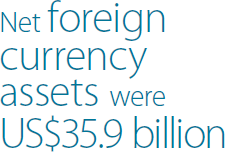
Official reserve assets are held by the Reserve Bank to facilitate various policy operations, including in the foreign exchange market (described above) and to assist the Australian Government in meeting its commitments to the IMF (discussed below). The Bank's capacity to undertake such operations is best measured by its foreign currency holdings net of any forward commitments (such as foreign currency the Bank has obtained from short-term swaps against the Australian dollar). As at 30 June 2017, net foreign currency assets were SDR25.8 billion and US$35.9 billion. (In Australian dollar terms, net foreign currency assets totalled $46.7 billion, a decrease of $1.7 billion from 12 months earlier, reflecting valuation effects.) The amount held represents the level assessed as necessary to meet policy requirements.
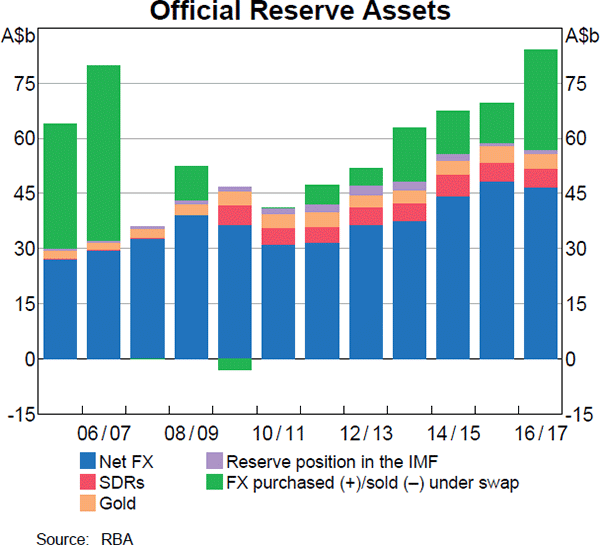
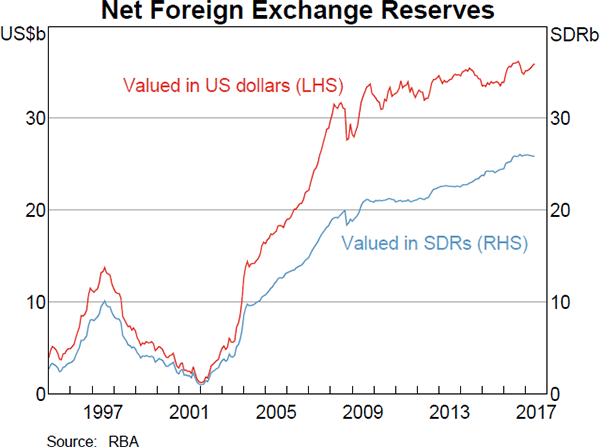
To ensure a strong balance sheet, the Reserve Bank holds capital against certain risks arising from its reserve assets (see the chapter on ‘Earnings, Distribution and Capital’ for more detail). These asset holdings can expose the Bank to market, liquidity and credit risk, which the Bank seeks to mitigate where possible, such as by holding a diversified portfolio and investing only in assets of high credit quality and appropriate liquidity (see the chapter on ‘Risk Management’ for more detail).
| US dollar | Euro | Japanese yen | Canadian dollar | Chinese renminbi | UK pound sterling | South Korean won | |
|---|---|---|---|---|---|---|---|
| Currency allocation (per cent of total) | 55 | 20 | 5 | 5 | 5 | 5 | 5 |
| Duration (months) | 6 | 6 | 6 | 6 | 18 | 3 | 18 |
|
Source: RBA |
|||||||
The composition of the Reserve Bank's net foreign currency assets is managed against an internally constructed benchmark. This benchmark is assessed to be the combination of foreign currencies and foreign currency assets that maximises the Bank's expected returns over the long run, subject to the Bank's tolerance for risk. The structure of the benchmark is reviewed periodically and in response to significant changes in market conditions.
During 2016/17, no changes were made to the currency allocation of the benchmark portfolio. The Reserve Bank maintains the largest allocation to the US dollar at 55 per cent, reflecting the significant liquidity in the US dollar currency and asset markets.
Reflecting the generally low level of global interest rates, duration targets have remained short for most of the foreign currency portfolios. Short duration targets mitigate the risk of capital losses in the event that yields in these currencies increase in the future.
Investments in the benchmark currencies are limited to deposits at official institutions (such as central banks) and debt instruments issued (or guaranteed) by sovereign entities, central banks and supranational agencies. Debt instruments issued by quasi-sovereign entities can also be accepted as collateral under reverse repos.
Sovereign credit exposures are currently limited to the United States, Germany, France, the Netherlands, Canada, Japan, China, the United Kingdom and South Korea.
At the end of June 2017, the Reserve Bank's foreign currency reserves included $27.5 billion of foreign currency sourced from swaps against Australian dollars. Foreign currency obtained in this manner does not comprise part of the benchmark portfolio but reflects domestic liquidity operations. It is invested to ensure that the Bank's forward commitments to sell foreign currency are hedged against currency and interest rate risk.
As has been the case for some years, when the cost of hedging currency risk is taken into account, yields on short-dated Japanese investments have generally exceeded those available in the other currencies in the Reserve Bank's portfolio. Reflecting this, the bulk of the foreign currency the Bank obtains from swaps against Australian dollars is Japanese yen.
For the same reason, the Reserve Bank also swaps other currencies in its foreign exchange reserves portfolio against the yen to enhance returns. As a consequence, while the Bank's exposure to changes in the value of the yen remains small (consistent with the yen's 5 per cent allocation in the benchmark), an additional $19.6 billion of yen was held at the end of June 2017 as a result of swaps against other foreign currencies in the portfolio.
A small component of the Reserve Bank's net foreign currency reserves sits outside the benchmark framework. This encompasses investments in a number of Asian debt markets through participation in the Executives' Meeting of East Asia and Pacific Central Banks (EMEAP) Asian Bond Fund Initiative. This initiative was established following the Asian currency crisis in the late 1990s to assist in the development of bond markets in the region. At the end of June 2017, the total allocation of the Bank's reserves to these funds was $596 million and the return on these investments in 2016/17 was −0.7 per cent when measured in SDR terms, because of capital losses on bond holdings and the depreciation of some Asian currencies.
| Currency | Securities held outright | Securities held under reverse repurchase agreements | Deposits at official institutions(b) | Total (gross) | Forward foreign exchange commitments |
Total (net) | |
|---|---|---|---|---|---|---|---|
| Against AUD | Against other currencies(c) | ||||||
| US dollar | 10,284 | 1,858 | 912 | 13,053 | 8 | 12,279 | 25,340 |
| Euro | 2,772 | – | 1,117 | 3,889 | 0 | 5,391 | 9,280 |
| Japanese yen | 30,381 | 696 | 18,283 | 49,361 | −27,497 | −19,642 | 2,222 |
| Canadian dollar | 1,383 | – | 5 | 1,387 | – | 942 | 2,329 |
| Chinese renminbi | 2,193 | – | 117 | 2,310 | – | – | 2,310 |
| UK pound sterling | 846 | – | 1 | 847 | 0 | 1,489 | 2,336 |
| South Korean won | 2,287 | – | 2 | 2,289 | – | – | 2,289 |
| Total | 50,147 | 2,554 | 20,436 | 73,137 | −27,489 | 459 | 46,107 |
|
(a) Excludes investments in the Asian Bond Fund Source: RBA |
|||||||
Measured in SDRs, the overall return on the Reserve Bank's foreign currency assets over 2016/17 was 1.0 per cent, slightly lower than the previous year but broadly in line with the average since 2011/12. This outcome reflected small contributions from interest income and exchange rate valuation effects, which were partially offset by capital losses on bond holdings. The running yield on the benchmark portfolio remained low at around 0.8 per cent, reflecting low or negative bond yields in a number of the major economies.
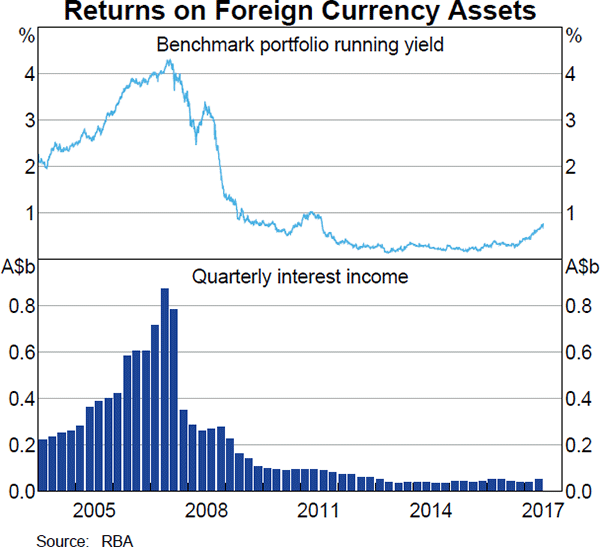
The Reserve Bank's holdings of SDRs at 30 June 2017 amounted to $5.1 billion, $0.2 billion higher than the previous year, as its net purchases of SDRs over the year more than offset the impact of the appreciation of the Australian dollar against the SDR. Under voluntary arrangements with the IMF, the Bank is willing to transact in SDRs upon request from other countries or prescribed holders. In these transactions, the Bank will generally either buy or sell SDRs in exchange for foreign currencies (such as euros or US dollars). While such transactions do not alter the level of Australia's reserve assets (only the respective proportions held in SDRs and foreign currency), the Bank occasionally chooses to replenish foreign currency sold in exchange for SDRs by purchasing additional foreign currency against Australian dollars in the spot market.
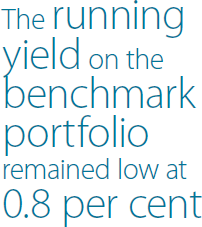
Australia's reserve position in the IMF comprises that part of Australia's quota in the IMF that is paid in foreign currency as well as other credit that Australia has extended to the IMF in support of its lending programs. At the end of June 2017, Australia's reserve position in the IMF was $1.1 billion, which was $251 million higher than the previous year. As noted above, Australia's reserve position in the IMF is not held on the Reserve Bank's balance sheet. However, the Bank will sell to (or purchase from) the Australian Treasury the foreign currency the Treasury needs to complete its transactions with the IMF. In contrast to other foreign exchange transactions with the Australian Government, the Bank will typically draw on (or add to) its foreign currency reserves when providing (or receiving) foreign currency for IMF-related purposes. Nevertheless, as with SDR transactions, on certain occasions the Bank may decide to offset the impact on foreign currency holdings of these IMF transactions by buying or selling foreign currency in exchange for Australian dollars in the spot market.
Gold holdings at the end of June 2017 were around 80 tonnes, unchanged from the previous year. Gold prices fell by 9.2 per cent in Australian dollar terms in 2016/17, decreasing the value of the Reserve Bank's holdings of gold by around $0.4 billion to $4.1 billion. At $0.74 million, income from gold loans was slightly higher than in recent years, as the Bank increased its lending activity marginally.
Bilateral currency swaps
In February 2017, the Reserve Bank renewed a bilateral local currency swap agreement with the Bank of Korea. The agreement allows for the exchange of local currencies between the two central banks of up to $10 billion or KRW 9 trillion. The agreement is for a further three years and can be extended by mutual consent. The Reserve Bank has similar agreements with the People's Bank of China, the Bank of Japan and Bank Indonesia. The purpose of these agreements is to allow each central bank to support trade settlement in local currencies, particularly in times of market stress, or to support financial stability.
Footnotes
A reverse repo involves an agreement to buy and then later sell securities; this is economically similar to a secured loan, with the difference between the purchase and sale price representing the interest earned on the transaction. [1]
While the use of foreign exchange swaps increases the Reserve Bank's holdings of foreign exchange, it has no effect on net foreign reserves, as the increased holdings of foreign exchange are matched with a commitment to sell foreign exchange at a pre-determined price and date. For the same reason, the use of swaps has no effect on the exchange rate. [2]
See https://www.rba.gov.au/mkt-operations/resources/tech-notes/eligible-securities.html. [3]
Some analysis of the securitisations data was included in a speech by Chris Aylmer, in his previous role as Head of Domestic Markets Department, in November 2016. See https://www.rba.gov.au/speeches/2016/sp-so-2016-11-22.html. [4]
The CLF legal documentation is available at https://www.rba.gov.au/mkt-operations/resources/tech-notes/pdf/clf-terms-and-conditions.pdf and https://www.rba.gov.au/mkt-operations/resources/tech-notes/clf-operational-notes.html. [5]